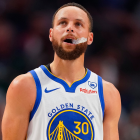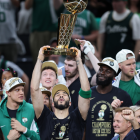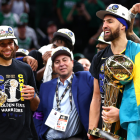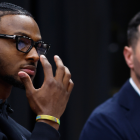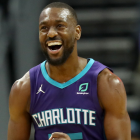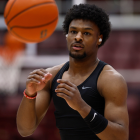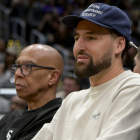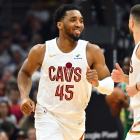The Indiana Pacers are finally and exclusively Paul George's team.
Back in 2010, the Pacers were coming off of a 32-win season and while Danny Granger was a budding, one-time All-Star for them, there were still a lot of question marks with where this roster was going. Roy Hibbert wasn't an effective defender yet. They didn't have David West. Frank Vogel hadn't taken over the sidelines in Indianapolis.
What they did have was Granger as their guy, a weak Eastern Conference to climb, and the 10th overall pick in the draft. That's when they had a bit of good fortune fall into their lap that would change the trajectory and ceiling of this franchise. Granger's knees were going to betray him in the next couple of years, West was going to sign a contract with the Pacers in 2011 after the lockout, and Hibbert was going to have a stretch as one of the best rim protectors in the game.
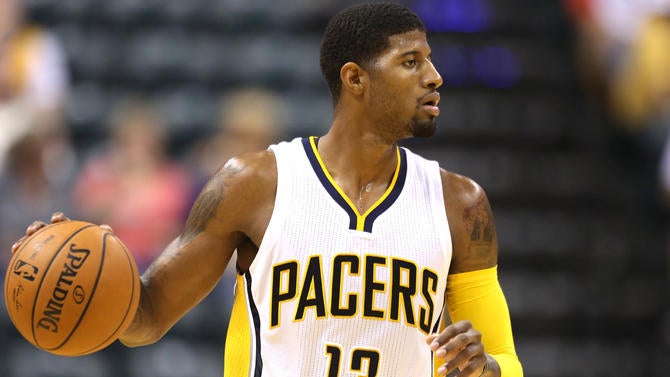
All of that positive movement in the franchise's favor was going to be buoyed by Paul George's selection with the 10th pick as guys like Wes Johnson, Ekpe Udoh, and Al-Farouq Aminu were selected ahead of George. And that's where the Pacers were essentially getting a superstar to fall into their laps. It took a year before it looked like George might be a real problem for the rest of the NBA. It took three years before he was being dapped/knighted by LeBron James in a huge playoff moment. A superstar was born by the end of Indiana's 2013 run and they were trying to be the curveball the Miami Heat couldn't hit.
All the while though, the Pacers were never put around George as the franchise guy. He was the franchise guy and the Pacers knew he was the franchise guy. The roster appeared to complement him quite well but instead of building around him, George mostly just emerged in the middle of the core. As the league got smaller and the Pacers naturally just seemed to have their approach dissipating with the era of lots of 3-point shooting, faster pace, and smaller lineups, Larry Bird looked to change the Pacers' roster approach to be a more modern offense.
There was the "struggle" to get George to be a small ball 4 and then the Pacers added Myles Turner in the draft and Monta Ellis in the summer in order to be able to replicate the small ball trend. They had their young, athletic big man to protect the rim and even hit some jumpers. Ellis was going to push the pace. Shooters were going to spread the floor. And after missing 76 games in 2014-15 from that horrific leg injury in the USA Basketball exhibition in 2014, George was returning to the court to remind everybody he's one of the best in the NBA.
It was a successful comeback season. George set career-highs in scoring (23.1), 3-pointers made (210), assist rate (20.3), and true shooting percentage (55.7). The Pacers made the postseason after a one-year hiatus and nearly toppled the 2-seed Toronto Raptors. But there was one problem with George and the Pacers that never seemed to go away: their superstar had to do everything. Almost too much.

It's kind of been a problem over the last two healthy seasons for George. During PG's breakout 2013-14 season he struggled a lot after the turn of the calendar year. From Jan. 1 through the end of the regular season, George shot just 39.5 percent from the field and 34.1 percent from 3-point range. He had an effective field goal of 45.6 percent during this time. During this same stretch, Ricky Rubio shot 40.2/32.5/43.2 (FG/3FG/eFG) for comparison. During a tumultuous end of the season for the Pacers, George wasn't quite what they needed him to be from a shot-making standpoint, but still obviously delivered as a defender.
This past season -- George's first full season back from the leg injury -- we saw another big swoon in accuracy from George. After a monster first month of the season in which he had a true shooting percentage of 62.3 percent with a usage rate just over 33 percent, teams adjusted to George and his shooting became wildly inconsistent. From the month of December to March 26 (56 games), George saw his shooting percentages dip to 39.9 percent from the field, 34.9 percent from deep, and an eFG of 46.8. These aren't disastrous numbers necessarily but tie them to a usage rate of 30.1 percent and it feels like he's forced into empty possessions.
He would rebound over the final nine games of the season and had a monster seven-game series against Toronto in the first-round, but the message was clear that Paul George needed a lot more help on offense not just making shots but also creating offense.
The Pacers head into this season with more ammunition to put alongside George, and it's really the first time in his career the roster has been totally tailored toward complementing him. It's not that the Pacers were reluctant before but roster construction, timing of contracts, and the emergence of George in a fairly meteoric rise left the Pacers a bit in the middle. They were built on the "Blue Collar, Gold Swagger" mantra they were selling to fans. Now, it appears they're built on the broad shoulders of George and without the comeback from the leg injury in the way, it could end up being the perfect storm of giving him help and maximizing an efficiency that was actually at a career-high for him despite that giant swoon in the middle of the season.
Acquiring Jeff Teague for George Hill brings in more of a playmaker to the offense. Bringing in guys like Al Jefferson and Thaddeus Young to score around the rim gives better safety valves for George as he attacks the basket. The offense of the team should generate a much higher offensive efficiency, which has often been lacking in Indianapolis during this run.
The tricky things for George though are twofold.
First, there isn't a ton of shooting on this team. Monta Ellis is a terrible 3-point shooter almost every season and while Teague knocked down 40 percent of his 3-pointers last season, he was a 34.4 percent shooter from deep the previous four seasons combined. Young won't provide any floor-stretching for them, but he's still a guy who can make a pass off a cut to help ball movement flow. This lack of shooting could constrict the floor and keep help defenders close to George as he attacks.
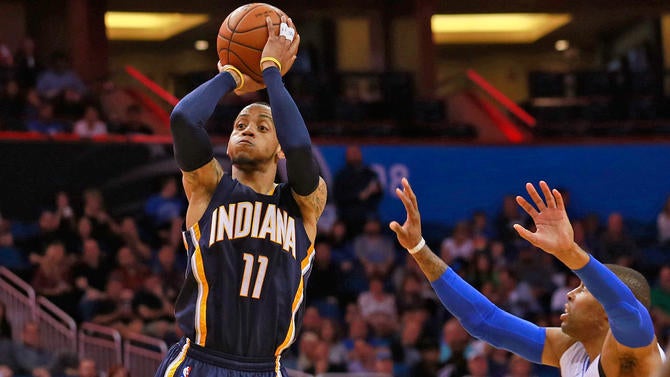
Second, we're not sure how Nate McMillan is going to help the situation. McMillan has always had his teams play notoriously slow, no matter how the roster was constructed. The idea of the Pacers playing fast seems far-fetched, but we still should wait and see if he'll adjust. George's usage rate was over 30 percent for the first time of his career (if we're not counting the six games he played in 2014-15). McMillan has often had key players have incredibly high usage rates.
Zach Randolph was at 33 percent one season in Portland. Brandon Roy and Ray Allen had high 20's usage often for him, which doesn't have to be a bad thing. But if there is a concern with wearing George out as the season goes along, striking a balance between PG leading the attack and having other weapons take some of the load off his plate is going to be key.
If the Pacers find that balance, not only will George have another career year but the Pacers will be built around him to make him an even bigger star in a successful manner. All of that matters in keeping the star feeling like things are moving in the right direction and proving to players around the league that he's the guy to play next to.
After all, this is his team; the way things are meant to be.










